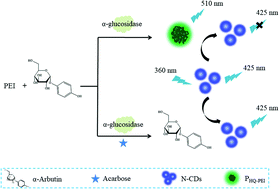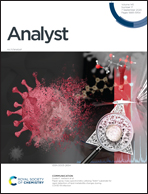A ratiometric fluorescent biosensor for the sensitive determination of α-glucosidase activity and acarbose based on N-doped carbon dots†
Abstract
In this work, a novel ratiometric fluorescent platform for α-glucosidase (α-glu) and its inhibitor was constructed based on N-doped carbon dots (N-CDs). The α-glucosidase present can catalyze the release of hydroquinone (HQ) from α-arbutin. Then, the generated HQ can be oxidized and copolymerized with polyethyleneimine (PEI) to form a yellowish green fluorescence copolymer (PHQ-PEI) with intense fluorescence emission at 510 nm. When the PHQ-PEI was formed, blue fluorescence of N-CDs at 425 nm was decreased, whereas the fluorescence of PHQ-PEI at 510 nm increased sharply as a result of the fluorescence resonance energy transfer (FRET) effect between N-CDs and PHQ-PEI. However, in the presence of acarbose, the activity of α-glucosidase is inhibited, and α-arbutin cannot be hydrolyzed to hydroquinone, leading to the fluorescence recovery of N-CDs at 425 nm and the fluorescence decrease of PHQ-PEI at 510 nm. The linear range from 0.2 to 1.6 mU mL−1 and 25–150 μmol L−1 was obtained for α-glucosidase and acarbose detection, respectively, and the detection limit (LOD) for α-glucosidase and acarbose was as low as 0.082 mU mL−1 and 14.5 μmol L−1. Thus, a ratiometric fluorescent sensor with good sensitivity and high specificity was established for α-glucosidase assay and satisfactory results were acquired in real sample determination.



 Please wait while we load your content...
Please wait while we load your content...